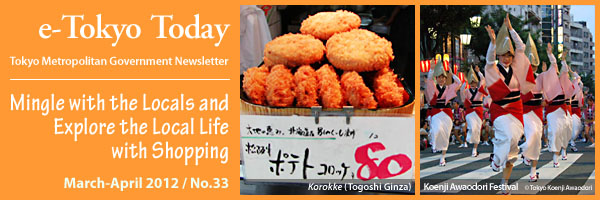
 |
|
News & Announcements |
|||
|
Shangri-La Hotel, Tokyo Chosen as Best Luxury Hotel in the World
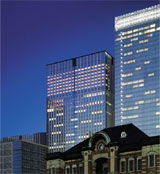 TripAdvisor®, the world's largest travel site, announced its "Traveler's Choice® 2012 Awards" and the award for the best luxury hotel in the world went to the Shangri-La Hotel, Tokyo. TripAdvisor®, the world's largest travel site, announced its "Traveler's Choice® 2012 Awards" and the award for the best luxury hotel in the world went to the Shangri-La Hotel, Tokyo.This status was awarded after compiling more than 60 million comments from worldwide hotel visitors. Located near Tokyo Station and close to the Imperial Palace, the Shangri-La Hotel, Tokyo, opened in 2009, is one of the most luxurious hotels in Tokyo. Travelers' Choice Hotel Awards - TripAdvisor |
|||
|
DiverCity Tokyo Plaza Open in Odaiba on April 19 : Fabulous Place to Have Fun for Family and Youth
DiverCity Tokyo Plaza will be home to both domestic and international fashion outlets, one of the largest food courts in Odaiba with about 700 seats, Maid Café and sports facilities where you can enjoy tennis, 3 on 3, bowling, and others. For non-Japanese visitors, the Plaza will have multilingual signage and a foreign exchange counter as well. The most immediate eye-catching feature of the site will undoubtedly be a giant, 18-meter lifelike statue of the anime character Gundam standing on the grounds in front of the building. In addition, on the 7th floor visitors can experience the world of Gundam in an entertainment space named Gundam Front Tokyo. (Please note: part of Gundam Front Tokyo is free of charge. You need to book prior to the visit for the charged part) DiverCity Tokyo Plaza (Japanese only) Gundam Front Tokyo (Japanese only) Access: 3 min from Tokyo Teleport Station on the Rinkai Line on foot, or 5 min from Daiba Station on the Yurikamome Line on foot |
|||
|
Opening of Omohara, New Landmark of Omotesando
 The intersection of Omotesando Avenue and Meiji-dori Avenue, about 5 minute’s walk from JR Harajuku Station will see the birth of a new landmark in April, Tokyu Plaza Omotesando Harajuku, or Omohara. Young Fashion lovers should definitely check out this new Tokyo fashion spot including flagship stores of popular fashion brands and "OMOHARA STATION" on the 3rd floor, a "popup space" featuring both foreign brand apparel and the latest Japanese brand fashion offerings.
The intersection of Omotesando Avenue and Meiji-dori Avenue, about 5 minute’s walk from JR Harajuku Station will see the birth of a new landmark in April, Tokyu Plaza Omotesando Harajuku, or Omohara. Young Fashion lovers should definitely check out this new Tokyo fashion spot including flagship stores of popular fashion brands and "OMOHARA STATION" on the 3rd floor, a "popup space" featuring both foreign brand apparel and the latest Japanese brand fashion offerings.Just like its neighbors such as Meiji Shrine and zelkova trees along Omotesando Avenue, the building is designed to be a place where you can feel fresh air, comfortable sunshine and green trees with several terraces, including the refreshing greenery on the rooftop rest area "Omohara no Mori" (Omohara Wood). Press Release [PDF] (Japanese only) |
|||
|
First Cabin, a Cabin-style Hotel, will Open at Haneda This Spring
First Cabin, a hotel chain of membership hotels emulating the first-class section of airplanes, will open a new hotel at Haneda Airport Terminal 1. Located inside the airport precincts, this functional, capsule hotel-like facility has no frills and perfectly suits the needs of Haneda Airport users, especially who fly early-morning or late-evening. You can also use the hotel in the daytime for waiting for flights or for having a rest. |
|||
|
The Sumida River (Sumidagawa), a New Tourist Destination
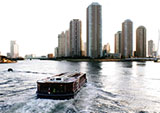 During the Edo period (1603-1867), the town of Edo (old name of Tokyo) was full of water networks, such as rivers, canals, and the moats around the Edo Castle. The Sumida River flowing in the northeast of Tokyo was an artery of transportation and also a hub of culture and art. As Japan’s modernization and economic growth proceeded, transportation shifted to land transportation and the river got less attractive for transportation and also for leisure. During the Edo period (1603-1867), the town of Edo (old name of Tokyo) was full of water networks, such as rivers, canals, and the moats around the Edo Castle. The Sumida River flowing in the northeast of Tokyo was an artery of transportation and also a hub of culture and art. As Japan’s modernization and economic growth proceeded, transportation shifted to land transportation and the river got less attractive for transportation and also for leisure.But now, the project "Sumida River Renaissance" is under way to make the river an attractive place for locals and also travelers again. Walking ways called "Sumida River Terrace" have been developed along the river and cafés have opened one after another. New cruising courses and illumination are being discussed. With the opening of the TOKYO SKYTREE in the vicinity on May 22, a variety of events are scheduled. Among them, "Tokyo Hotaru" (Tokyo fireflies), a light and sound event with a motif of fireflies, will take place on May 5 and 6. Sumidagawa River Area |
|||
|
Tokyo Museum Grutt Pass (Round-Trip Pass) 2012
It widely covers a range of facilities from the must-see ones to the well-kept secrets. Newly added are renovated Tokyo Metropolitan Art Museum, Setagaya Museum, and four others. The new version for 2012 is to be sold from April 1 at 2,000 yen and on sale until January 31, 2013. "GRUTT PASS 2012" 75 facilities Guide of "Tokyo Museum - Grutt Pass 2011 [PDF] (information for 2011) |
|||
|
Mingle with the Locals and Explore the Local Life while Shopping |
|||||
|
Chatting with the local residents is a joy of traveling. Strolling around shopping districts is one of the best ways to feel this. Ameyoko in Ueno, Nakamise in Asakusa, and Takeshita-dori (Takashita Street) in Harajuku are very popular sightseeing places because of the great shopping and fun people watching. But they are only the tip of the iceberg. There are rumored 2,683 shopping streets in Tokyo! Here are some of the shopping streets in Tokyo that are well worth visiting. 1) "Ginza": Shopping for Daily Life
Ginza is one of the most prestigious shopping districts in Tokyo. And the name "Ginza" has become synonymous with shopping. It is said there are about 300 other, more daily life 'Ginza' shopping districts in Japan.Togoshi Ginza Shopping Street: The first "Ginza" shopping street in Japan 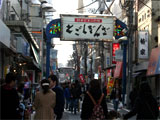 Exit Togoshi-Ginza Station on the Tokyu Ikegami Line, and enter the hustle and bustle of Togoshi Ginza Shopping Street. It is the longest (about 1.3 km) shopping street in Tokyo and has about 400 shops. Exit Togoshi-Ginza Station on the Tokyu Ikegami Line, and enter the hustle and bustle of Togoshi Ginza Shopping Street. It is the longest (about 1.3 km) shopping street in Tokyo and has about 400 shops.A specialty of the area is korokke, deep-fried patties covered with bread crumbs similar to French croquettes. Many shops sell them and prices range from 60 yen to 800 yen (1USD=82 yen). Each shop boasts their own korokke recipes and a wide variety of fillings, flavors, and shapes can be found. Why not try one of the many unique korokke? In addition to korokke, the shops are full of delicious finger foods easy to eat while walking such as dumplings, menchi-katsu (deep-fried minced meat patty rolled in bread crumbs), fried chicken, and yakitori. You can also buy original "Togoshi Ginza Brand" products sold only here. Togoshi Shopping Street is also proud of being the first "everyday" shopping street in Japan named after the real "Ginza." In fact, some of the bricks used in Togoshi Ginza are from the original Ginza, giving the area the "Ginza" moniker. Togoshi Ginza is not far from Ikegami Honmon-ji Temple where the Oeshiki festival takes place in October. Access: Togoshi-ginza Station on the Tokyu Ikegami Line, or Togoshi Station on the Toei Asakusa Line Togoshi Ginza Shopping Street (Tokyo Tourism Info) Togoshi Ginza Shopping Street (Japanese only) Yanaka Ginza Shopping Street: Stroll around shitamachi or "old downtown" and watch the sunset 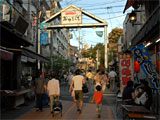 Yanaka Ginza is a must-see in Ya-Ne-Sen, a shitamachi district in eastern Tokyo including Yanaka, Nezu, and Sendagi districts, which is a popular place for strolling because of its charming atmosphere with the more "commoner" side of old Japanese life. Many of the old houses and original winding streets remain unchanged as the area was not badly damaged by the Great Kanto Earthquake in 1923 or the Great Tokyo Air Raids of 1945. Yanaka Ginza is a must-see in Ya-Ne-Sen, a shitamachi district in eastern Tokyo including Yanaka, Nezu, and Sendagi districts, which is a popular place for strolling because of its charming atmosphere with the more "commoner" side of old Japanese life. Many of the old houses and original winding streets remain unchanged as the area was not badly damaged by the Great Kanto Earthquake in 1923 or the Great Tokyo Air Raids of 1945. The 150-meter shopping street has an atmosphere of the bygone days of Japan and leads to the famous "Yuyake Dandan" (Sunset Stairs) steps. The view of the sunset from the top of the steps is worth the climb. Many of the stores sell cute Japanese sundry goods, popular with both locals and tourists. Many locals time their shopping for early evening. The 1st and 15th of every month are 10% discount days. A walking map is available at Yanesen Tourist Info. Access: Sendagi Station on the Tokyo Metro Chiyoda Line, or Nippori Station on the JR Yamanote Line Sunamachi Ginza: Bustling "retro" shopping street 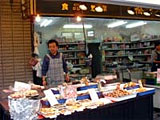 This joyful shopping street has a feel and look of the olden days of Japan. There are more than 100 shops lining the narrow 1-km long shopping street. The beautifully showcased vegetables, dishes, and other foods are mesmerizing. A variety of daily take-out dishes such as yakitori, tempura and fried chicken are offered and the aroma alone whets the appetite. Restaurants serving udon noodles, sushi, Western-style dishes, and Chinese food are also numerous. The area hasn’t changed much in the last 50 years ago and has retained its warm, neighborly feeling. It is a good place to feel the energy and rhythm of the daily life of the locals. This joyful shopping street has a feel and look of the olden days of Japan. There are more than 100 shops lining the narrow 1-km long shopping street. The beautifully showcased vegetables, dishes, and other foods are mesmerizing. A variety of daily take-out dishes such as yakitori, tempura and fried chicken are offered and the aroma alone whets the appetite. Restaurants serving udon noodles, sushi, Western-style dishes, and Chinese food are also numerous. The area hasn’t changed much in the last 50 years ago and has retained its warm, neighborly feeling. It is a good place to feel the energy and rhythm of the daily life of the locals.Bus transportation to the area is the most convenient. More visitors come on weekends than weekdays and often there is a line waiting to enter many of the shops. Access: 15 minutes by bus from Kinshicho Station on the JR Sobu Line/Tokyo Metro Hanzomon Line, 5 minutes by bus from Nishi-ojima Station on the Toei Shinjuku Line Sunamachi Ginza Shopping District 2) Shopping Streets in the Center of Tokyo
Kagurazaka-dori (Kagurazaka Street) Shopping Street: The heart of the long past nightlife in quaint alleyways 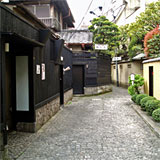 Get off at JR Iidabashi Station, cross the Ushigome Bridge over the Sotobori moat and you will find yourself at the base of Kagurazaka-dori, a short slope of about 400 meters from Kagurazaka-shita crossing. Leisurely stroll up the street while shopping at the many Japanese traditional stores. Zenkokuji Temple (Kagurazaka Bishamon-ten) is at the top. Get off at JR Iidabashi Station, cross the Ushigome Bridge over the Sotobori moat and you will find yourself at the base of Kagurazaka-dori, a short slope of about 400 meters from Kagurazaka-shita crossing. Leisurely stroll up the street while shopping at the many Japanese traditional stores. Zenkokuji Temple (Kagurazaka Bishamon-ten) is at the top.The area became commercial as classic Japanese restaurants with geisha sprang up in the middle of the 19th century, and, early in the 20th century, became one of the most famous nightlife districts of Tokyo. What makes Kagurazaka stand out is its unique mixed atmosphere: many people from France live in the area, leading to an ample number of French restaurants in this old area, where the original Edo period layout of the streets with slopes and side alleys has been retained despite WWII devastation. The small, cobble-stoned alleyways off the main Kagurazaka Street brings to mind the elegant ambience of yesteryear. Don't get lost in the labyrinth! Access: Kagurazaka Station on the Tokyo Metro Tozai Line, Ushigome-kagurazaka Station on the Toei Oedo Line, Iidabashi Station on the JR Chuo/Sobu<Local> Line/ Toei Oedo Line/Tokyo Metro Tozai, Yurakucho, and Namboku lines Shinjuku City Tourism Association Japanese Street and an Oasis in the Heart of the City Ningyocho Shopping Street: The very mood of traditional Edo, with its original old town 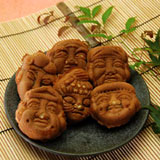 Ningyocho is less well-known than the famous Nakamise Shopping Street in Asakusa but it has a unique atmosphere. Visitors come to Suitengu Shrine, famous for endowing fertility and easy delivery, and the business districts nearby and so the shopping street is always bustling. Ningyocho is less well-known than the famous Nakamise Shopping Street in Asakusa but it has a unique atmosphere. Visitors come to Suitengu Shrine, famous for endowing fertility and easy delivery, and the business districts nearby and so the shopping street is always bustling.There are many ningyo-yaki vendors and people line up to buy these treats that are sweet handmade cakes molded into the shapes of the Shichifuku-jin (Seven Deities of Good Luck). Amazake-yokocho, an old alley area, is like being in a time warp. It is named Amazake (sweet sake) yokocho (shopping street) because in the good old days there used to be sweet sake shops all around the main entrance. Today, shopkeepers are still busy in the many shops selling traditional crafts such as tsuzura (traditional lacquered woven bamboo boxes) and shamisen (three string guitars). There are many things to see that are typical and endemic to old central Edo. A map of the shopping street is available at at the office of Chuo-ku Commerce and Industry Associations. Ningyocho is close to Takarada Ebisu Shrine, where Bettara-ichi Fair is held. Access: Ningyocho Station on the Tokyo Metro Hibiya Line/Toei Asakusa Line, or Suitengumae Station on the Tokyo Metro Hanzomon Line Ningyocho Shopping Street Azabujuban Shopping Street: Fusion of old, modern and cosmopolitan 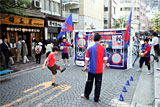 Azabujuban prospered in the Edo period and is the home of many long-established shops selling traditional sweets, bean snacks, Tanuki-senbei rice crackers and more. It has long been an essential shopping area for the neighborhood but, with the development of Roppongi Hills, it has become a popular tourist destination in the center of Tokyo. In and around this town are more than a few interesting, sophisticated shops worth checking out. Azabujuban prospered in the Edo period and is the home of many long-established shops selling traditional sweets, bean snacks, Tanuki-senbei rice crackers and more. It has long been an essential shopping area for the neighborhood but, with the development of Roppongi Hills, it has become a popular tourist destination in the center of Tokyo. In and around this town are more than a few interesting, sophisticated shops worth checking out.As there are many embassies, many foreign families live, shop and dine in this area, creating a very cosmopolitan atmosphere. Have a delicious soba (buckwheat noodle) meal, see the latest fashions at a stylish boutique, or have a rest at a cozy café. Or enjoy ethnic food, shop for museum-quality antique furniture and vintage kimono, or pick up some items at a local delicatessen. This is the place to discover new things and feel the fusion of old and new, East and West. Access: Azabu-juban Station on the Toei Oedo Line/Tokyo Metro Namboku Line Azabujuban shopping street 3) Shopping Streets in Suburb of Tokyo Koenji: Unique shops in a subculture town 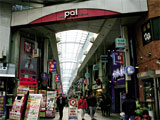 Koenji, a district along the JR Chuo Line in west Tokyo, is full of subculture and ethnic shops. The number of used-clothing stores is particularly of note. A 5-minute walk from the station through the Pal Arcade on the right of the South Exit of JR Koenji Station brings you to the entrance of Look Street. This area survived WWII without any damage and pre-war stores create the retro atmosphere. It’s a great place for the young to come and 'look' for the latest fashions. Koenji, a district along the JR Chuo Line in west Tokyo, is full of subculture and ethnic shops. The number of used-clothing stores is particularly of note. A 5-minute walk from the station through the Pal Arcade on the right of the South Exit of JR Koenji Station brings you to the entrance of Look Street. This area survived WWII without any damage and pre-war stores create the retro atmosphere. It’s a great place for the young to come and 'look' for the latest fashions.Koenji is not just limited to used-closing stores; it is also known for a role in the Tokyo music scene including clubs with live music and record & CD shops. Indeed, it is said that Koenji is the place to find any type of music from anywhere in the world. There are numerous small shops with owners buying and selling rare, hard-to-find items. In addition to used clothing and rare music, used bookstores and old toy shops are also seen. Wandering around Koenji is never boring. Awaodori Festival, begun in 1957 and held here every August, is a signature event of Tokyo in summer. For further information, check Event Information. Access: Koenji Station on the JR Chuo Line Shimo-Kitazawa: Vintage shops popular with the young 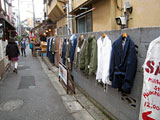 The narrow alleys spreading out from the North Exit of Shimo-Kitazawa Station are lined with small shops. This area has many vintage clothing and variety shops, making the area itself popular among young people. The old building that houses the food market in front of the station is thronged with people. The district has a fashionable yet nostalgic atmosphere and is home to many rather small theaters. Why not explore the town and feel the energy of the place? The narrow alleys spreading out from the North Exit of Shimo-Kitazawa Station are lined with small shops. This area has many vintage clothing and variety shops, making the area itself popular among young people. The old building that houses the food market in front of the station is thronged with people. The district has a fashionable yet nostalgic atmosphere and is home to many rather small theaters. Why not explore the town and feel the energy of the place?Access: Shimo-Kitazawa Station on the Odakyu Line/Keio Inokashira Line A retro atmosphere: Komaba and Shimo-kitazawa (Half Day) [Shimo-kitazawa] Travel Route Sugamo Jizo-dori Shopping Street: "Harajuku" for old ladies
Nearby is Rikugien Gardens, a good example of the renowned gardens built in the Edo period completed in 1702. Ikebukuro Station, the transportation hub of northeast Tokyo, is two stations from Sugamo Station on the Yamanote Line. Access: Sugamo Station on the JR Yamanote Line/Toei Mita Line, or Koshinzuka Station on the Toden Arakawa Line Togenuki Jizo Toshima City Tourism Association Kameido Katori Kachiun Shopping Street: Tourist shopping street with retro "signboard architecture"
Access: Kameido Station on the JR Sobu Line/Tobu Kameido Line Map-stroll around Kameido Katori [PDF] 4) Specialized Shop Streets
Tokyo also has specialized shopping areas. Almost any item you are looking can be found in one of them. Ochanomizu, Ogawamachi, and Jimbocho: Music instruments, sports goods, and old books 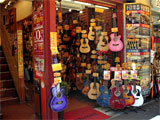 Take the Ochanomizu-bashi Exit from JR Ochanomizu Station and go down the slope to the left, to find a plethora of instrumental shops. Music freaks gather to look for fine or rare instruments. Most instruments such as electric guitars, keyboards, drums, tambourines, ocarinas, and other folk instruments are available. There are many used records and music scores for sale, too.
Take the Ochanomizu-bashi Exit from JR Ochanomizu Station and go down the slope to the left, to find a plethora of instrumental shops. Music freaks gather to look for fine or rare instruments. Most instruments such as electric guitars, keyboards, drums, tambourines, ocarinas, and other folk instruments are available. There are many used records and music scores for sale, too.Further down the street at Surugadaishita Crossing are all the sports shops along Yasukuni-dori selling equipment for skiing, snowboarding, and other sports activities. The area from Surugadaishita to Jimbocho to the west is the Kanda Koshoten-gai district with about 160 used bookstores. If you’re looking for a rare or antique book, this is the place to go. If you become exhausted from looking at so many books, take a break at one of the unique cafés nearby. Access: Ochanomizu Station on the JR Chuo Line/Tokyo Metro Marunouchi Line, Awajicho Station on the Tokyo Metro Marunouchi Line, Shin-ochanomizu Station on the Tokyo Metro Chiyoda Line, Ogawamachi Station on the Toei Shinjuku Line, or Jimbocho Station on the Toei Shinjuku and Mita lines/Tokyo Metro Hanzomon Line Akihabara and Ochanomizu Kappabashi Dougu Street: Cooking tools for professionals 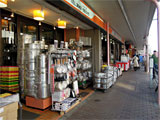 A huge variety of tools and utensils for culinary professionals can be found at the about 170 shops along the 800-meter street. Signboards and lanterns for restaurants are also available. The fascinating and realistic replicas of sushi, snacks and even full course menus are available and are popular as souvenirs. Small items such as key chains are also sold. The area is about a 10-minute walk from Asakusa. A huge variety of tools and utensils for culinary professionals can be found at the about 170 shops along the 800-meter street. Signboards and lanterns for restaurants are also available. The fascinating and realistic replicas of sushi, snacks and even full course menus are available and are popular as souvenirs. Small items such as key chains are also sold. The area is about a 10-minute walk from Asakusa.Access: Tawaramachi Station on the Tokyo Metro Ginza Line Tokyo Kappabashi Dougu Street Promotion Union The many chances to experience the various facets of typical Japanese daily life will make your travel special. Go on an adventurous excursion in search of the real Tokyo! |
|||||
Event Information |
|||
Tokyo Koenji Awaodori (Tokyo Koenji Awa Dance Festival)
Awaodori is originally a traditional dance festival in Tokushima Prefecture, in western Japan, and has a 400-year history. At this Festival, more than 10,000 dancers participate in this exciting parade and dance to the accompaniment of jaunty musical rhythm. More than 1 million people converge to watch. Visit and feel the energetic power of the big carnival of Tokyo in summertime. Venue: From the South Exit of Koenji Station to Ome Kaido Street August 25 (Sat)-26 (Sun), 2012 Tokyo Koenji Awa-Odori Association (information for 2011) |
|||
|
Ikegami Honmon-ji Oeshiki
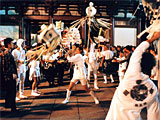 The Oeshiki ritual ceremony, in which people commemorate the spirit of the Buddhist Priest Nichiren, is annually held on the anniversary of his death for three days from October 11 through 13. The Oeshiki ritual ceremony, in which people commemorate the spirit of the Buddhist Priest Nichiren, is annually held on the anniversary of his death for three days from October 11 through 13.In Mandoh-Neri-Kuyoh in the evening of the 12th, a long procession of more than 3,000 people walk with lanterns and flags in their hands 2 km from Ikegami Station to Honmon-ji Temple. As many as 300,000 people flock to see the event. It takes about 15 minutes from Ikegami to Togoshi-ginza by train. It is sure to be interesting to feel the contemporary Tokyoite’s energy at the shopping street and also feel the solemn feeling of the traditional memorial service. Venue: Ikegami Honmon-ji Temple and areas nearby October 11 (Fri)-13 (Sun), 2012 Ikegami HONMONJI Oeshiki (information for 2011) |
|||
|
Bettara-ichi Fair
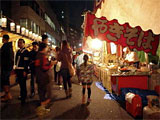 With about 500 stalls lining the streets and vendors hustling to sell their foods and goods, the Bettara-ichi Fair annually takes place around Takarada Ebisu Shrine in Nihombashi on October 19 and 20. Lanterns are lit up in the evening, which enhance the festive mood, and portable shrines parade in the town.
With about 500 stalls lining the streets and vendors hustling to sell their foods and goods, the Bettara-ichi Fair annually takes place around Takarada Ebisu Shrine in Nihombashi on October 19 and 20. Lanterns are lit up in the evening, which enhance the festive mood, and portable shrines parade in the town.Takarada Ebisu Shrine, worshiped as the dwelling of the god of commerce since the 17th century, hosts "Ebisu-ko," a festival to pray for prosperity in business, on October 20 every year. For preparation of the festival, a fair started selling fish, vegetables, other foods, and tools for Ebisu-ko on the eve of the festival. As bettara-zuke, a lightly pickled daikon radish made with sugar, rice and rice malt always sold well, the fair began to be called "Bettara-ichi" (ichi means a fair) and take place under that name down until today. Go and try one of the popular specialties of Tokyo while enjoying a hustle and bustle atmosphere of the traditional Tokyo! Venue: Area around Takarada Ebisu Shrine October 19 (Fri)-20 (Sun), 2012 Nihonbashi Ebisu-ko Bettara-ichi (Pickle Fair) Nihonbashi Odenma Seinenbu (Japanese only) |
|||
Did you Know? Fun Facts About Tokyo |
|||
Shopping Street Where USD Accepted
Fussa is close to attractive sightseeing spots, such as Showa Kinen Park where a variety of flowers bloom every season, and old sake brewer where you can enjoy seeing the brewing process and tasting. Street Map Showa Kinen Park Ishikawa Brewery Tamura Shuzoujou (Brewery) (Japanese only) |
|||
|
No Negative Impact on Our Health: Updated Radiation-related Information in Tokyo
|
|
Radiation Level in the Air (Tokyo Metropolitan Institute of Public Health)
Environmental radiation levels in Tokyo Radiation Level in Tap Water (Bureau of Waterworks Tokyo Metropolitan Government) No radioactive substances have been detected either from raw water or at the water purification plants of Tokyo since April 2011. Latest information related to the effect on purified water by radioactivity List of banned foods and shipping restrictions Food products are monitored every day for radioactive materials. The Japanese government restricts distribution and consumption of food products containing any level of radiation that exceeds the regulatory standards. Ministry of Health, Labour and Welfare: Information on the Great East Japan Earthquake Q&A on Foods and Fishery products Ministry of Agriculture, Forestry and Fisheries: Revised FAQ on vegetables, shiitake mushroom, rice, milk, dairy products, meat and eggs (as of February 14) Fisheries Agency: Questions and answers on fishery products |
